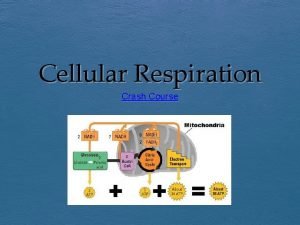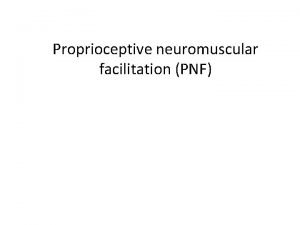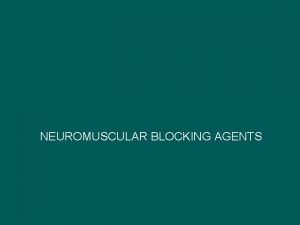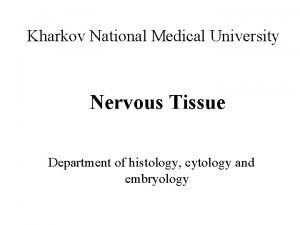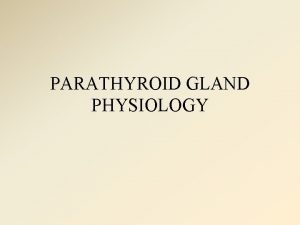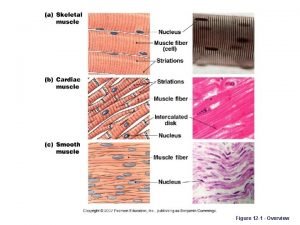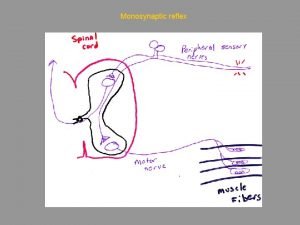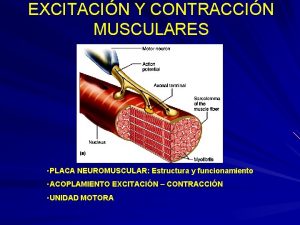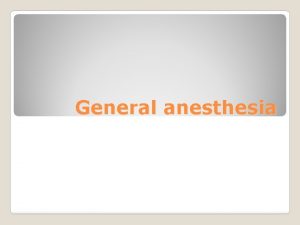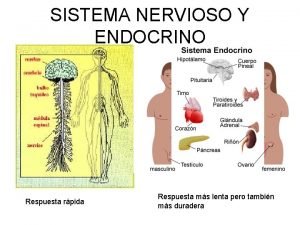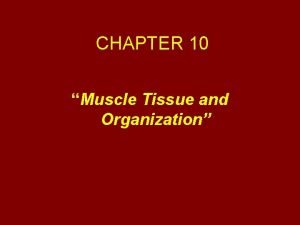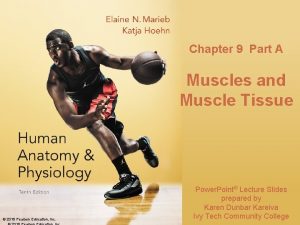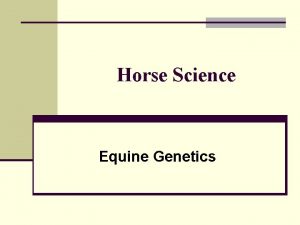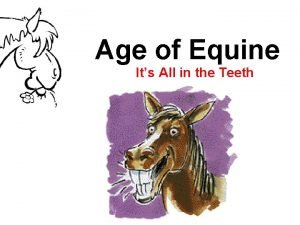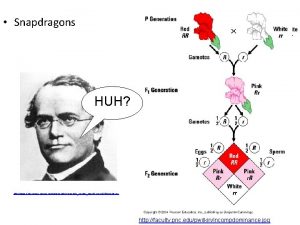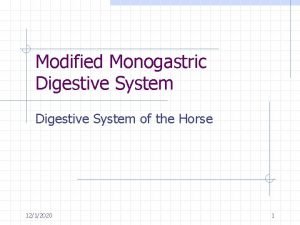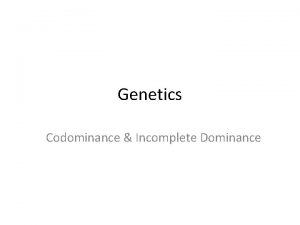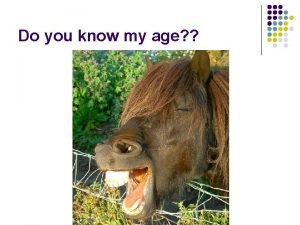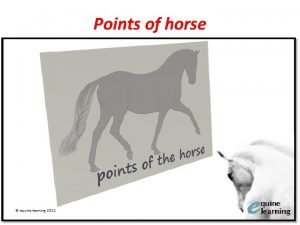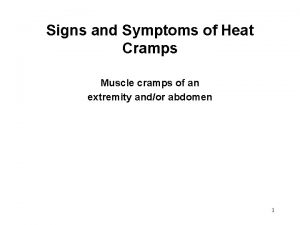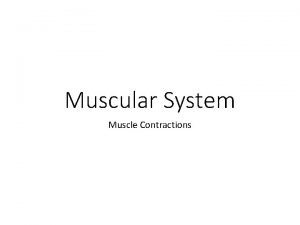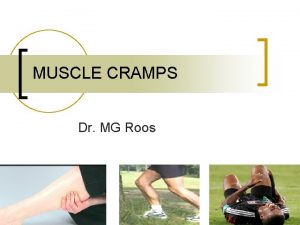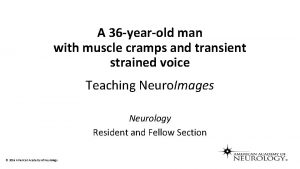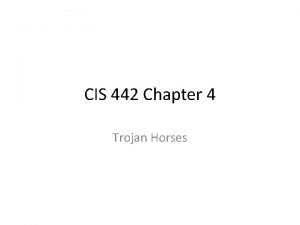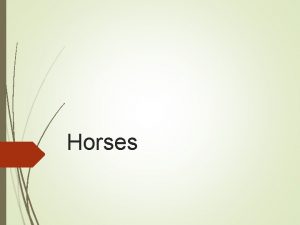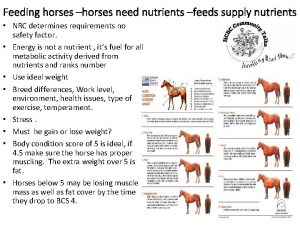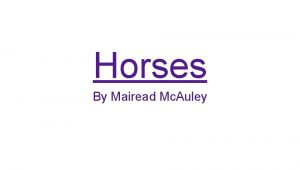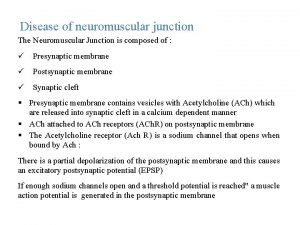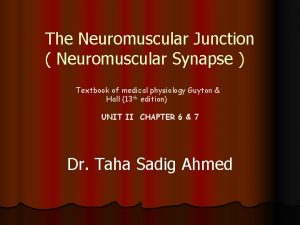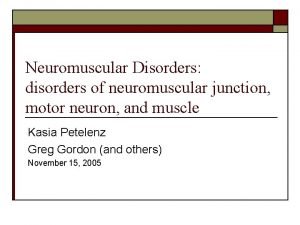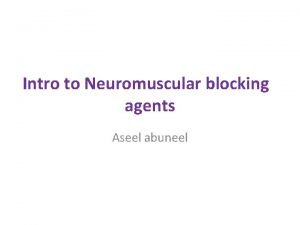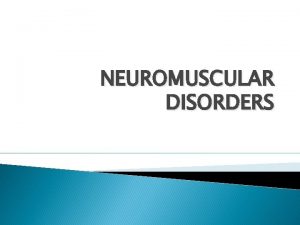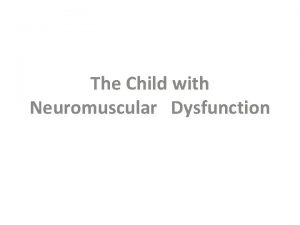Reigning in Charleys Horses Muscle cramps in Neuromuscular















































- Slides: 47

Reigning in Charley’s Horses Muscle cramps in Neuromuscular Disease Dr. Hans Katzberg MD Msc FRCPC Assistant Professor of Medicine, University of Toronto Prosserman Centre for Neuromuscular Diseases Toronto General Hospital

Objectives 1) To define muscle cramps and be able to distinguish them from other hyperexcitable neurological phenomena 2) To review the pathophysiology and electrophysiology underlying the development of neurogenic muscle cramps 3) To understand current management strategies in the care of patients with neurogenic muscle cramps 4) To describe current and novel methods of assessing muscle cramps clinically and in clinical research

Outline What is a muscle cramp? Electrophysiology and pathophysiology Cramps across the spectrum of disease and health Treatment of muscle cramps Guidelines (AAN, Cochrane) Clinical practice Research Outcome measures

Disclosures I serve as a consultant and participate in clinical research studies for Flexpharma (treatments for muscle cramps), IVIG companies Octapharma, CSL Behring, Grifols and for Sanofi-Genzyme I am hold a grant from the University of Toronto for the development of a clinical cramp index for muscle cramps

Origins “Charley Horse”

Origins “Charley Horse” A lame horse named Charley pulled the roller on the Chicago White Sox ballpark in the 1890 s. Boston Globe, 17 July 1886: Joe Quest, said to have experienced “charlie horse” The pitcher Charley Radbourne (Boston) was nicknamed Old Hoss. He got cramp during a baseball game in the 1880 s.

Origins “Charley Horse” “Choppers”or “Corky” Terminology England : “dead leg”, “granddaddy”, “chopper” Terminology Australia: “corked thigh” or "corky” Link with US terminology? Policemen in 17 th century England were supposed to be called Charleys and the term migrated to America. The amount of walking the police were required to do gave them aching legs.

Definition : Muscle Cramps • Acutely painful, explosive onset, resulting in visible, palpable contraction in one muscle or part of a muscle, with persistent soreness • Associate with trivial movements or forceful contraction (especially in already shortened muscle) • Stretching the muscle usually terminates cramp • A neurogenic cramp has a specific needle electromyographic signature, namely high frequency (50 -150 Hz) continuous discharges, which distinguishes it from other hyperexcitable muscle conditions Miller et al. Muscle Nerve 2005. Men’s Health June 2015

Cramp Discharges on EMG

Evaluation of Cramp Potentials • ~50 motor units were identified from the intramuscular EMG recordings. • The average discharge rate over the interval of activity was 14. 5 Hz. • A relatively small proportion of motor units (6/48) had peak rates >30 Hz. • Bursts of 150 stimuli at frequencies increasing from 4 Hz at increments of 2 Hz until the cramp was elicited. • • The presence of a cramp was assessed by 1) subject feedback 2) clinical observation 3) presence of involuntary EMG activity Minetto et al. J Neurophysiology 2009.

What is NOT a muscle cramp? EMG may be useful to identify hyperexcitable neurological phenomena Cramps may co-exist with other neuropathic findings or phenomena Outside the experimental setting, it is not routine to elicit muscle cramps during assessment Katzberg HD. Journal of Neurology 2015

Muscle Cramps: Pathophysiology Image courtesy of Kimberly Chin Katzberg HD. Journal of Neurology 2015

Prevalence of Muscle Cramps Muscle cramp are uncommon in children under age eight Leung AK et al. JAMA. 1999; 91(6): 329– 32 Muscle cramps appear to be common in adolescents / young adults In a survey of 121 college students: 115 had experienced at least one muscle cramp 18 had been awoken from sleep more than twice a month with muscle cramps. Norris FH. Electro Neurophysiol 1957; 9: 139 -47. Cramps can become more of a problem in older ages A cross-sectional prevalence study of 365 outpatients aged 65 or older in the UK reports that 50% of outpatients report frequent cramps 2. Abdulla AJ. Int J Clin Pract. 1999; 53: 494– 496.

Garrison et al. CMAJ 2015

Causes of Neurogenic Muscle Cramps Physiological Metabolic disorders No underlying condition (IDIOPATHIC) Uremia Nocturnal leg cramps in elderly Cirrhosis Exercise related cramps Hypothyroidism Pregnancy Acute extracellular volume depletion Perspiration (“heat cramps”) Lower motor neuron disorders • ALS • Polio/post-polio • Radiculopathy • Neuropathy Hemodialysis Diarrhea, vomiting PNS Medications Long acting B 2 agonists Thiazide(like) diuretics • Neurological conditions K+ sparing diuretics • Parkinson’s Disease Loop diuretics • Multiple Sclerosis • Stroke CNS Statins Garrison et al. Arch Int Med 2012

Cirrhosis / Hemodialysis Cirrosis: May be caused by the reduction of the effective circulating volume Weekly infusion of human albumin may be an effective treatment Hemodialysis: Changes in plasma osmolality and/or extracellular fluid volume have been implicated Occurs in 33 to 86 percent of patients Often result in the early termination of a hemodialysis and therefore a significant cause of underdialysis Hepatology 1996 Feb; 23(2): 264 -73 Adv Chronic Kidney Dis 2011. Nov; 18(6): 428 -32

Cramps in Pregnancy Young G. BMJ Clinical Evidence 2009.

Causes of Neurogenic Muscle Cramps Lim Fat and Katzberg J Ank Foot Res 2012.

Prevalence of Cramps in Diabetes 242 patients with diabetic neuropathy enrolled in a trial with Epalrestat or Methylcobalamine had a rate of muscle cramps of 76. 5– 78. 2% at baseline 1 1 Maladkar et al. Int J Diabetes Dev Ctries. 2009. 2 Maxwell S, Kokokyi S, Lovblom E, Perkins B, Bril V, Katzberg H. Diabetes Care 2009.

• Muscle cramps are a common and frequently disabling symptom, which may affect physical quality of life in patients with polyneuropathy. • Equal prevalence and characteristics of muscle cramps across different types of neuropathies, including small fiber neuropathy Neuromuscular Disorders 2014 • 12 patients with muscle cramps and without symptoms of neuropathy underwent skin punch biopsy • Intraepidermal nerve fiber density reduced in 7 patients, only 1 identified to have cause for neuropathy Muscle Nerve 2013

Cramp Fasciculation Syndrome Patients with muscle aching, cramps, stiffness, exercise intolerance, and peripheral nerve hyperexcitability Neurologic examination showed calf fasciculations, quadriceps and deltoid myokymia Nerve stimulation at 0. 5, 1, 2, and 5 Hz produced showers of electrical potentials following the M response Voltage Gated K+ Channelopathy Cramps, stiffness, fasciculations, myokymia can accompany neuromyotonia; afterdischarges and continuous motor activity on EMG Associated myasthenia gravis or thymoma, and rarely lung cancer Can be associated with voltage gated potassium channel antibodies (LGI 1 and CASPR) If associated with central nervous system pathology, can be related to Isaac’s Syndrome Carbamazepine therapy caused moderate-to-marked reduction of symptoms and nerve hyperexcitability. Tahmoush et al. Neurology 1991 41: 1021. Neurol Clinics. 2010; 28(4): 941 -59.

Cramp after discharges Figure 1. (A) Normal Study. (B) After-discharges. (C) Cramp Potential. (D) Continuous Motor Unit Activity.

Familial Cramps No specific genetic target has been implicated in patients with muscle cramps Based on selected families identified with muscle cramps, there may be a hereditary component Most families reported to have an autosomal dominant inherited pattern Jacobsen JH et al. Sleep. 1986; 9: 54– 60. At TGH, 3 identified families with autosomal dominant inherited pattern prominent muscle cramps with a total of 10 affected people

Investigations not required if cramps are: • • Situational (after exercise) Infrequent Slow RNS even at 5 Hz may be normal, especially if cramps are infrequent VGKC not routinely tested, only if suspicion of neuromyotonia or Isaac’s syndrome Katzberg HD. Journal of Neurology 2015

Quinine Sulphate Quinine and derivative used to treat muscle cramps since uncontrolled studies in the 1940 s Inc refractory period, reducing response to repetitive stimulation Reduces motor end plate excitability diminished response to nerve stimulation / Ach • “Due to continued reports of serious side effects patients using Qualaquin "off-label” for night time leg cramps, the U. S. Food and Drug Administration (FDA) has approved a risk management plan to warn against use for such unapproved uses. Qualaquin should not be used for night time leg cramps. ” Harvey 1939, Gootnick 1943; Moss 1940; Nicholson 1945.

• 563 articles identified if prospective clinical trial with effect on muscle cramps as a primary or secondary outcome (18 randomized tx trials) • 2 Class I studies showed modest benefit of efficacy of quinine derivatives • “Although likely effective (Level A), quinine derivatives should be avoided for routine use in the management of muscle cramps because of the potential of toxicity, but in select patients they can be considered for an individual therapeutic trial once potential side effects are taken into account. ” Katzberg H, Kahn A, So YT. Neurology 2010.

• There is one Class II study each to support the use of: • Vitamin B complex • Naftidrofuryl • Calcium channel blockers (diltiezam, verapamil) • Intramuscular lidocaine • These Rx are possibly effective and may be considered in management of muscle cramps (Level C) • No clinical trials have systematically evaluated antiepileptics such as carbemazepine or dilantin or anti-spasmodics such as baclofen for treatment of muscle cramps Katzberg H, Kahn A, So YT. Neurology 2010.

Cramps in ALS (Cochrane) Twenty studies including 4789 participants were identified. Vitamin E, baclofen, riluzole, L-threonine, xaliproden, indinavir, and memantine (13 trials, 20 outcome) No Effect One trial of tetrahydrocannabinol (THC) as 10 endpoint. Creatine, gabapentin, dextromethorphan, quinidine, and lithium (6 studies as adverse event) Authors' conclusions No evidence to support use of any intervention for muscle cramps in ALS/MND. More / larger randomised controlled trials evaluating treatments for muscle cramps in ALS/MND are needed. Balinger R, Katzberg H, Weber M. Cochrane Syst Database Rev. 2012 Apr 18; 4: CD 004157.

Mexilitine for Cramps 2 small studies in idiopathic muscle cramps (14 patients) and Machado Joseph Syndrome (20 patients) showed possible benefit of the drug over placebo Kanai, et al. Brain 2003 Mexilitine had significant effects on cramp frequency (31% of placebo 300 mg, 16% of placebo 900 mg) and cramp intensity (45% of placebo 300 mg, 25% of placebo 900 mg) Higher rate of discontinuation due to adverse events at 900 mg dose Weiss, et al. Neurology Feb 2016.

Practice Patterns in the Treatment of Muscle Cramps in Ontario Lim Fat and Katzberg. J Ankle Foot 2011

Practice Patterns in the Treatment of Muscle Cramps in Ontario Lim Fat and Katzberg. J Ankle Foot 2011

Practice Patterns Amongst Neuromuscular Clinicians in US

Treatment of Muscle Cramps Katzberg HD. Journal of Neurology 2015

Treatment Flowchart Pregnancy Magnesium Sulphate (360 mg or 15 mmol Mg citrate/ lactate) Neurogenic Cramps Hemodialysis Cirrhosis Variable Na profiling Weekly albumin infusions Mild Stretching / hydration Vitamin supplementation (Vit B /E) Ca channel blockers (diltiezam 30 mg / verapamil 120 mg) Brewer’s yeast Over the counter quinine (15 mg quinine) Medications, B 12, Lytes, thyroid, parathyroid Moderate-severe Quinine Sulphate 300 mg qhs Baclofen 10 -50 mg od Clonazepam 0. 5 -2 mg / day Mexilitine 300 mg 600 mg Gabapentin 3003600 mg od Crampfasciculation / VGKC/abn S-RNS Antiepileptic Rx Carbemazepine / Oxcarbazepine Leveteracitam Phenytoin

Patient Centred Outcome Research Institute (PCORI) Patient Assisted Intervention for Neuropathy: Comparison of Treatment in Real Life Situations (PAIN-CONTRo. LS) Assessment of Prevention, Diagnosis, and Treatment Options Using prospective randomized comparative effectiveness adaptive design study on patients suffering from neuropathic pain Bayesian adaptive design used Medications evaluated including nortypyline, duloxetine, pregabalin, mexilitine Research funded through a Patient-Centered Outcomes Research Institute (PCORI) Award (CER-1306 -02496) P. I. Richard J. Barohn

Patient Centred Outcome Research Institute (PCORI) Pharmacologial interventions for treatment of muscle cramps: (INFORMEd) Assessment of Prevention, Diagnosis, and Treatment Options Similar statistical analysis used to PAIN-CONTROLS study Collaborators: University of Kansas (Barohn, ), University of Buffalo (N. Silvestri), University of Toronto (Katzberg) Medications planned for study include: mexilitine, oxcarbazepine, quinine sulphate, baclofen In preparation : Co-P. I. ’s Nick Silverstri / Hans Katzberg

How have cramps traditionally been measured in cramp trials? Cramp frequency has been used most frequently in clinical studies but may not comprehensively capture the entire cramp experience.

Is the more to the cramp experience than frequency? • Patients seen at the UHN neuromuscular clinic with cramps were asked about frequency, severity, duration and location of muscle cramps as well as disability due to cramps via questionnaire. 25 • There is currently an urgent need for new therapeutic option to treat muscle cramps, in addition to reliable and validated tools to assess the severity and impact of cramps. 20 15 10 Cramp Severity (0 -10) 10 9 -9. 9 8 -8. 9 7 -7. 9 6 -6. 9 5 -5. 9 4 -4. 9 3 -3. 9 2 -2. 9 0 1 -1. 9 5 0 -0. 9 Data from 225 patients showed that all parameters including pain on a visual analogue scale, duration of muscle cramps and cramp frequency correlate well with self-reported disability from muscle cramps (r>0. 6) and factors not thought to matter, such as pain from cramps, appear to be pseuonormally distributed Number of Patients •

Development of Neuromuscular Outcome Scales at TGH Toronto Clinical Neuropathy Score (TCNS and m. TCNS) “All seven clinical scales were determined to be excellent in discriminating between patients with neuropathy from controls without neuropathy. The strongest discrimination was seen with the m. TCNS. The best sensitivity and specificity for the range of scores obtained, as determined by using receiver operating characteristic curves, was seen for the m. TCNS followed by the TNSc. ” Zilliox et al. J Diabetes and Complications 2015 • Myasthenia Gravis Impairment Index (MGI 2) • Evaluation of electrophysiogical correlates of as well as minimal clinical important differences in • • QMGS Critical analysis of QMGS+MG-composite scales with traditional and Rasch methods Development of a practical, validated, responsive, reliable, patient-centered index for MG Barnett et al. Muscle Nerve 2013. Katzberg HD et al. J Clin Neuromusc Dis 2012. Barnett C et al. PLo. S 1 Katzberg HD et al. Muscle Nerve 2014.

Development of a Novel, Patient-centred Cramp Index: Toronto Clinical Cramp Index (TCCI) Literature review Qualitative data Previous measures Preliminary Items Measurement Experts Local Neurologists DRAFT VERSION 1 Patients: Cognitive interviews PRO items Survey to Neuromuscular physicians and nurses DRAFT VERSION 2 FIELD TESTING, VALIDATION, RELIABILITY AND RESPONSIVENESS

Cramp Interviews (qualitative data) • Script developed and used in semistructured interviews to additional patients with cramps: • polyneuropathy, • motor neuron disease • idiopathic cramps • pregnancy-induced cramps • cramps related to cirrhosis and hemodialysis. • Development of a cramp index from the interviews includes: • item generation and reduction using a data saturation method • starts by developing a conceptual framework of cramp severity based on qualitative data of patent experience. DIAGNOSIS GENDER AGE (yrs) Idiopathic M F 28 50 DURATION OF INTERVIEW 27 min 10 sec 41 min 12 sec Diabetes + Liver Cirrhosis M 58 25 min 15 sec Diabetes ALS F M 70 55 40 min 42 sec 18 min 38 sec Liver Cirrhosis F 75 47 min 25 sec Pregnancy F 27 16 min 40 sec Exercise induced cramps M 48 17 min 47 sec Chronic Renal Failure F 65 10 min 19 sec

Quotes “I might get two hours of sleep a night, some nights I don't sleep at all. So it certainly affects me during the day, I am more irritable, just not focused at work” “From a dead sleep, I'll just wake up in screaming pain” “Muscles are rock solid and I can't move. ” “It's hideous. It hurts too much to cry. ” “I can't get into the bathtub, and if I'm in the bathtub, I won't be able to get out because that's going to entail bending my leg. ” “I imagine that the pain is AS severe as having a heart attack. ”

Grouped Codes (samples) Duration Location Bad cramps lasting for minutes Bilateral leg cramps Duration of cramps on feet Circle of pain around the leg Less severe cramps lasting less than 30 s Cramps in hamstrings quads and adductors Nocturnal cramps lasting 10 to 20 minutes Sudden onset of cramps Cramps in hands Cramps more in thighs Impact: Evening/ Sleep Created Harm/Danger Lack of sleep affects work Cramping in the pool Waking up from sleep Danger won't be able to get out of bath tub Cramps in the evenings Visiting ER due to severe cramps Cramps start when getting home from work Cramps waking up at night due to pain Waking up due to cramps Severe cramp caused a pulled knee ligament Regular cramps causing disability Did not miss work until recently when cramps injured.

Cramp Domains Cramp Severity Cramp Impact

Frequency Cramp Severity Duration Intensity Location Harm Impairment Day Cramp Impact Avoidance Night Excessive daytime sleepiness Sleep interference

Conclusions Neurogenic muscle cramps are a common and potentially disabling condition in many disease states as well as normal individuals Care must be taken to distinguish neurogenic muscle cramps from other neurological and non-neurological phenomena A rational treatment approach should be used when treating patients with muscle cramps In addition to exploring new pharmacological options for treatment of muscle cramp, efforts should be made to ensure cramp assessment are patient centered, comprehensive, accurate and reliable across populations

 Early period symptoms
Early period symptoms Period symptoms vs pregnancy symptoms
Period symptoms vs pregnancy symptoms Crash course glycolysis
Crash course glycolysis Definition of pnf
Definition of pnf Neostigmine atropine reversal
Neostigmine atropine reversal Neurofibrils
Neurofibrils Rocuronium dose
Rocuronium dose Why does hypocalcemia cause tetany
Why does hypocalcemia cause tetany Figure 12-4
Figure 12-4 Neuromuscular
Neuromuscular Neuromuscular junction
Neuromuscular junction Neuromuscular transmission steps
Neuromuscular transmission steps Placa neuro muscular
Placa neuro muscular Residual neuromuscular block
Residual neuromuscular block Acondicionamiento neuromuscular dibujos
Acondicionamiento neuromuscular dibujos Mielencefalo
Mielencefalo Neuromuscular junction
Neuromuscular junction Huso neuromuscular
Huso neuromuscular Focus figure 9.2: excitation-contraction coupling
Focus figure 9.2: excitation-contraction coupling _____ muscles run across the cheek.
_____ muscles run across the cheek. Different types of muscle cells
Different types of muscle cells Herda gene in horses
Herda gene in horses Nimiipuu language
Nimiipuu language 7 year hook horse teeth
7 year hook horse teeth Carl andre
Carl andre How do horses move in chess
How do horses move in chess Dobermannreview
Dobermannreview Modified monogastric animals
Modified monogastric animals Sovereign quarter horses
Sovereign quarter horses Example of codominance
Example of codominance Codominant
Codominant Beloved horses hateful man
Beloved horses hateful man 7 year hook horse teeth
7 year hook horse teeth Point of the horse
Point of the horse Horse evolution chart
Horse evolution chart Trojan horses spyware and worms are all forms of
Trojan horses spyware and worms are all forms of The levi strauss trademark shows two horses
The levi strauss trademark shows two horses Where is a horses vagina
Where is a horses vagina Bad horse conformation pictures
Bad horse conformation pictures All the king's horses kurt vonnegut
All the king's horses kurt vonnegut Diamond v yeast for horses
Diamond v yeast for horses Hold your horses idiom meaning and sentence
Hold your horses idiom meaning and sentence Horses hate surprise parties
Horses hate surprise parties Light breeds
Light breeds Some may trust in horses
Some may trust in horses Ted hughes the horses
Ted hughes the horses Jamie payton movie horses
Jamie payton movie horses Black cowboy, wild horses comprehension questions
Black cowboy, wild horses comprehension questions


